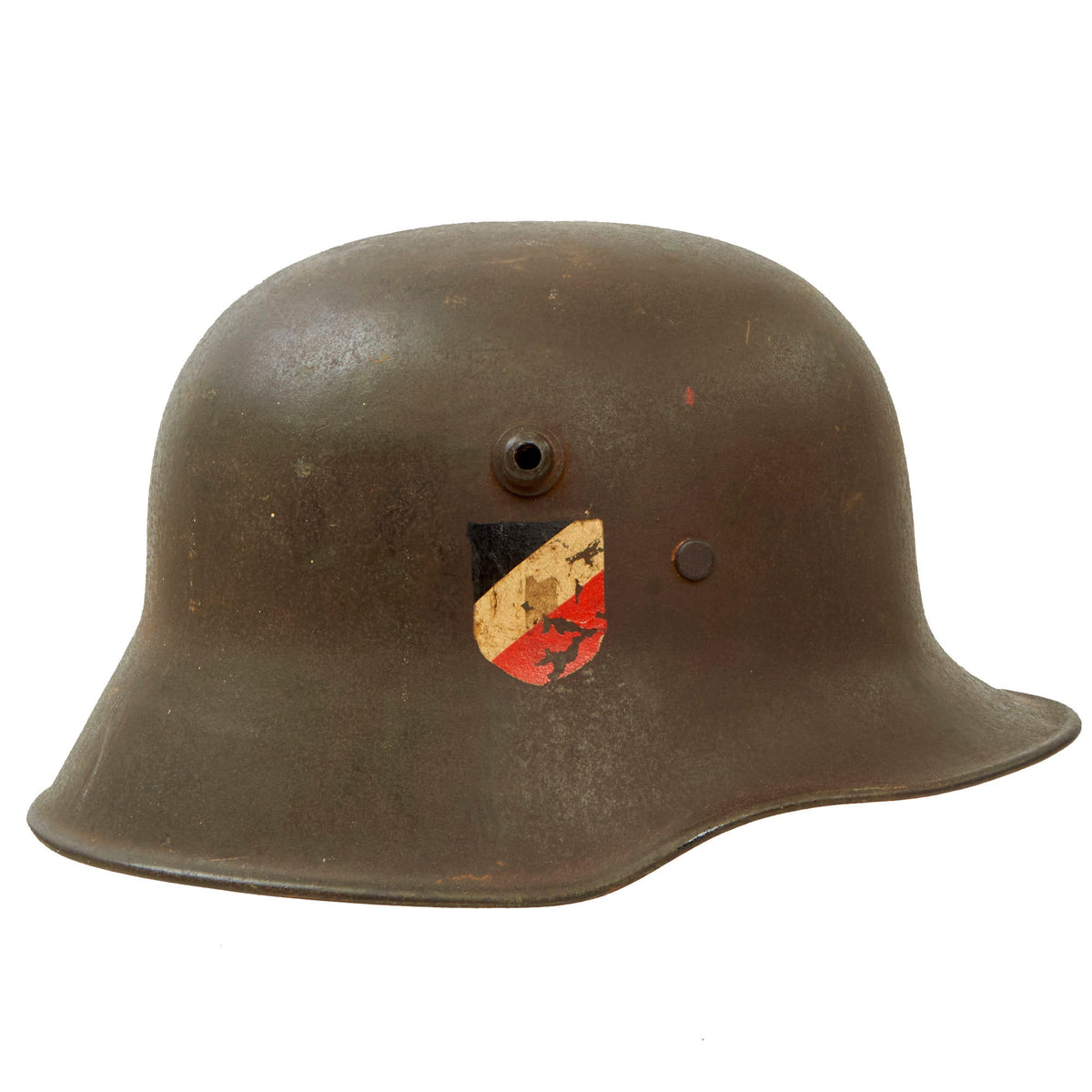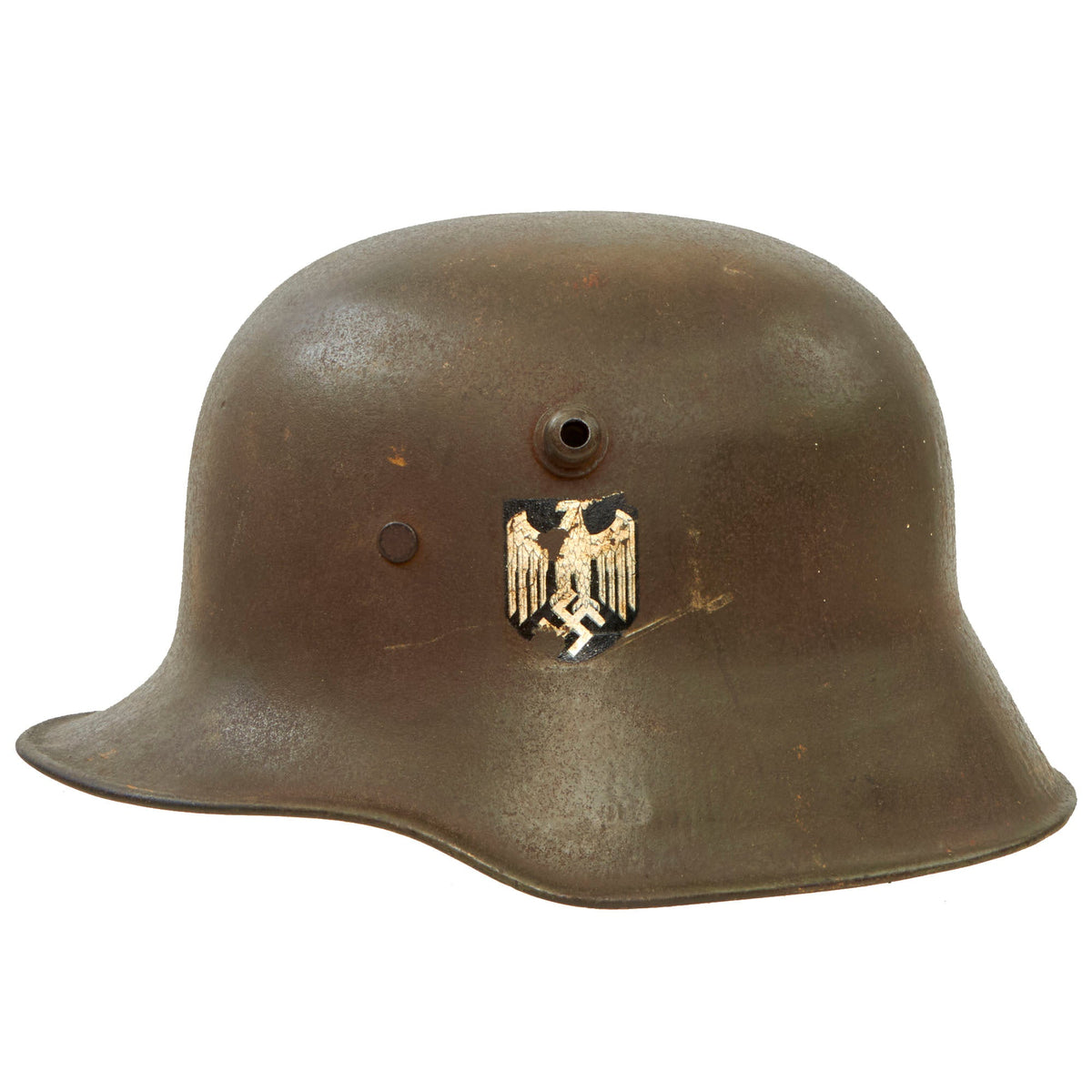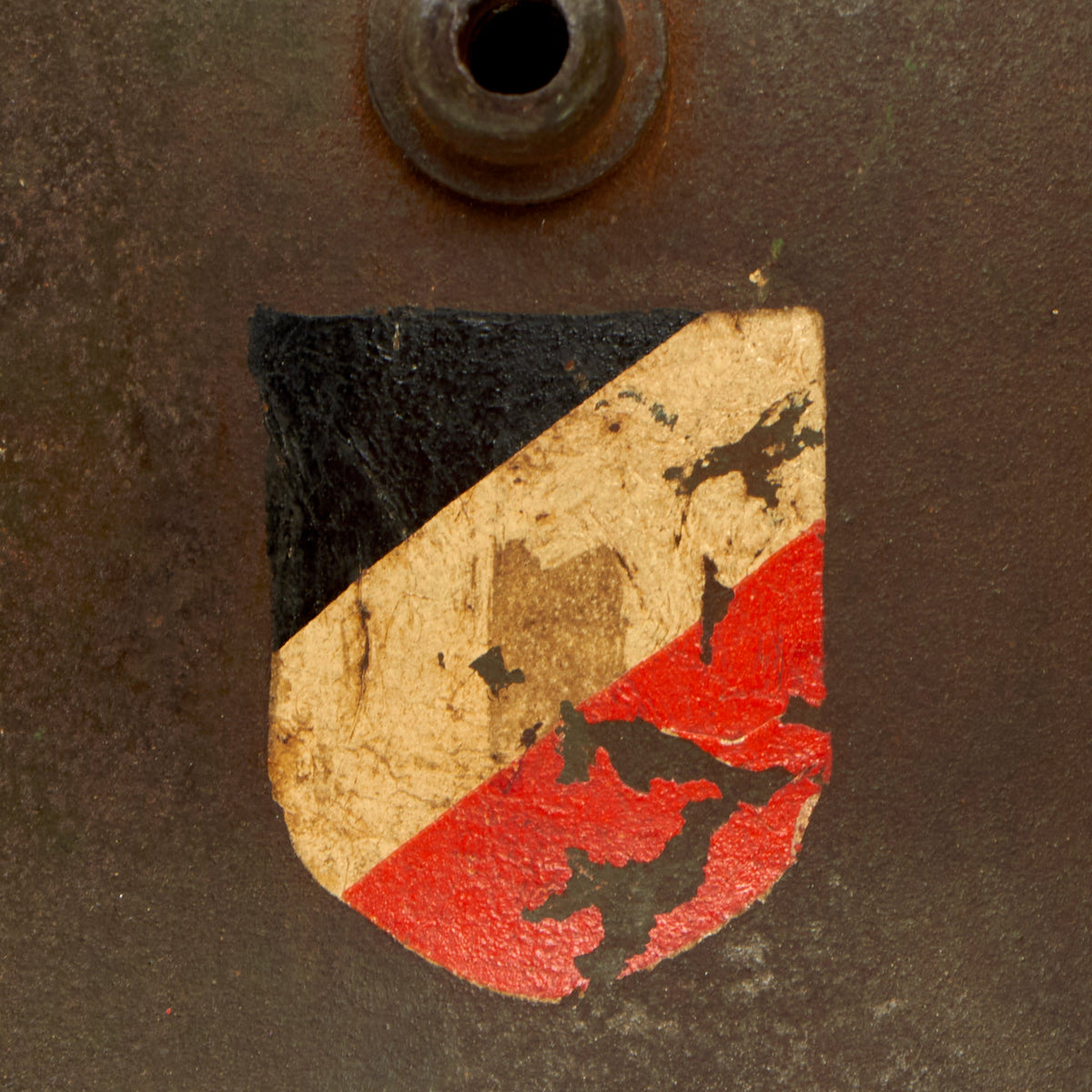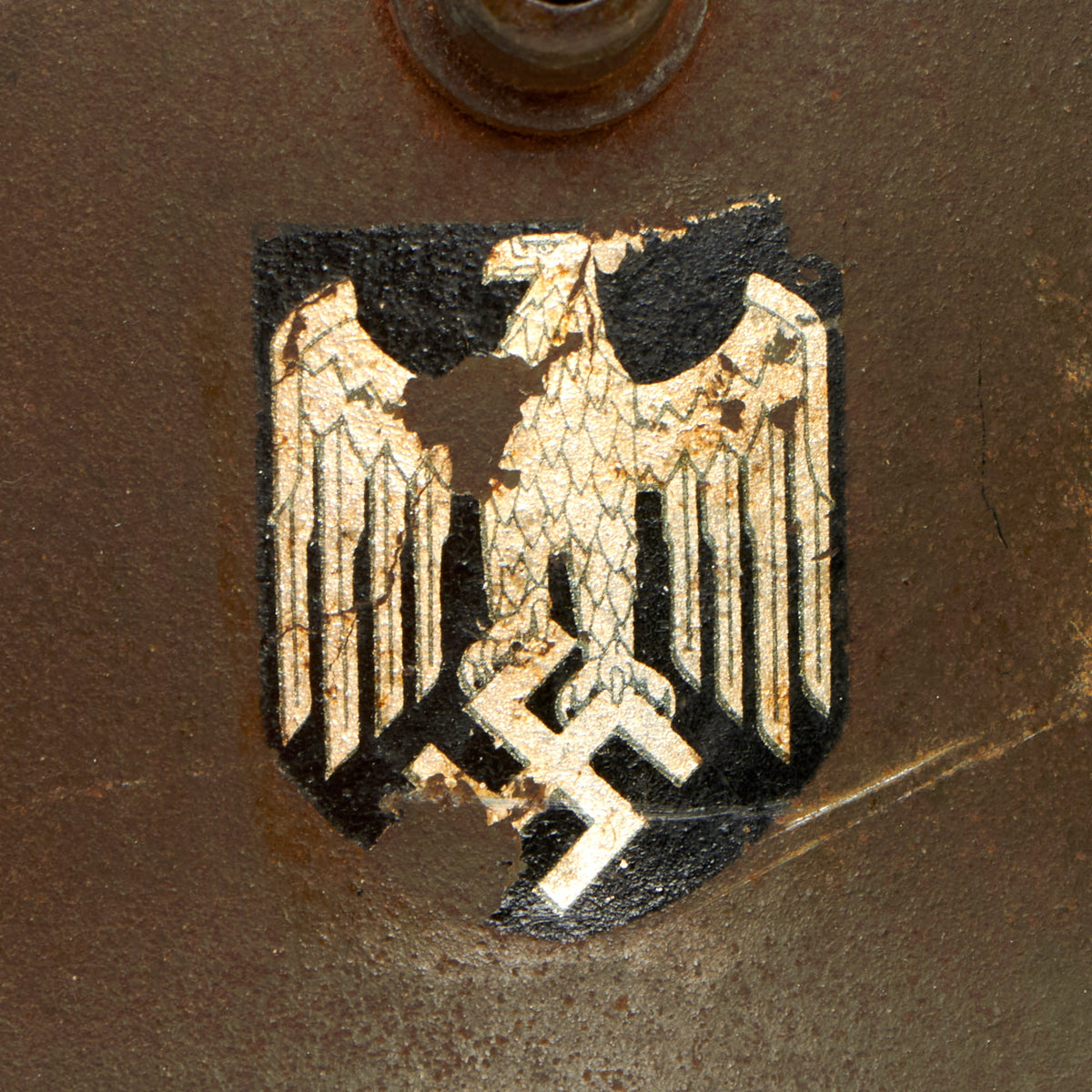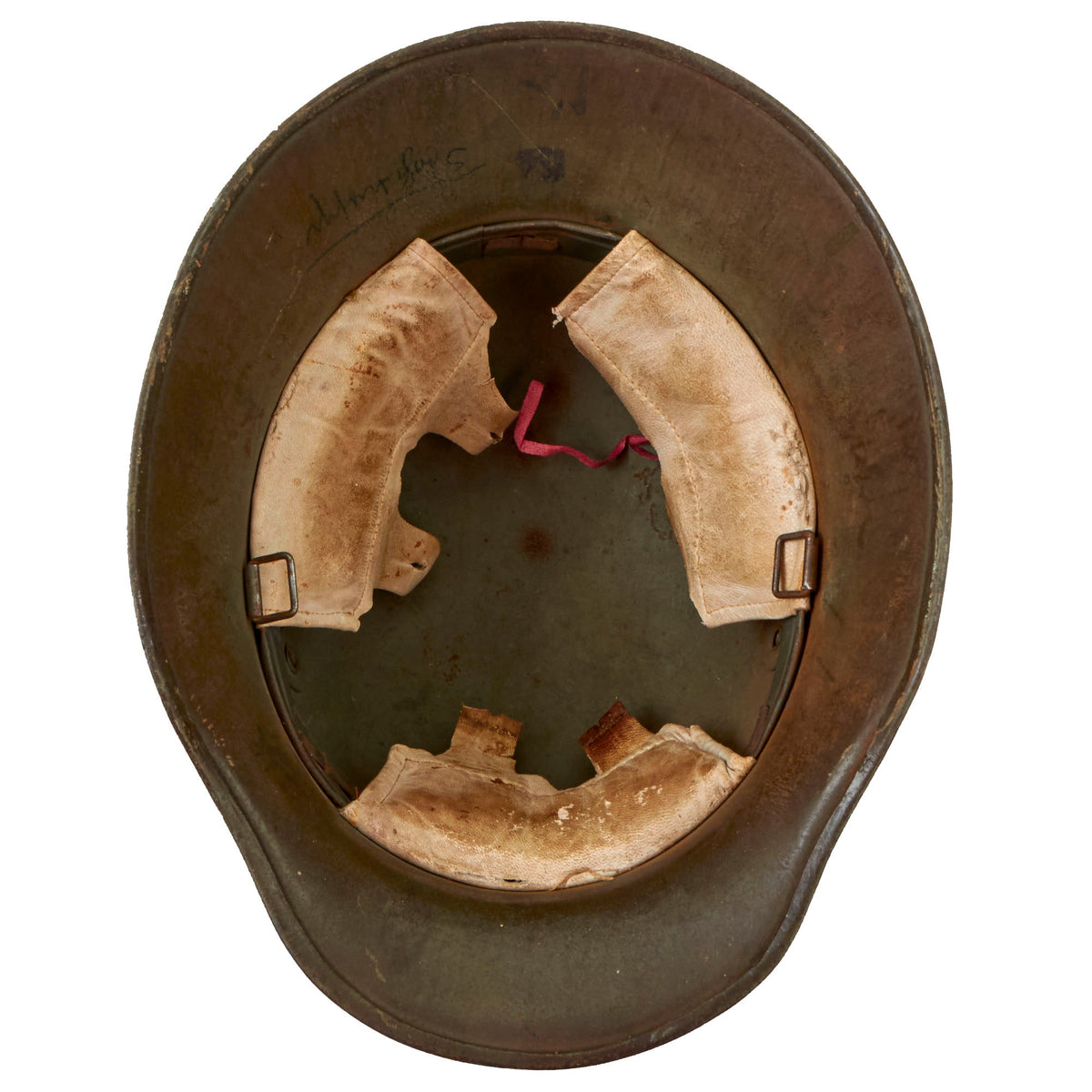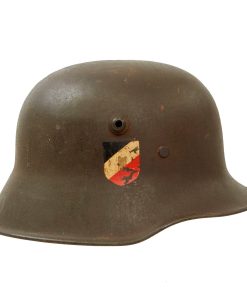Original German WWII M18 Transitional Heer Army Double Decal Helmet with Interwar Liner – Stamped “Bell” L64 Original Items
$ 1.395,00 $ 348,75
Original Item: Only One Available. This is a lovely example of a WWI M18 helmet, which was converted for use by the Third Reich in the 1930s before the widespread issue of the M1935 helmet. During the process it looks like may have been repainted with Pre-War Apfel-grün (apple green), and the helmet liner looks to have had the leather portions replaced during the interwar period. It was then fitted with Heer “Double Decals”, a Heer (army) eagle over the left ear, and the German Tri-color “National Colors” decal, over the right ear.
After that, it did see long service, with the paint now showing an overall oxidized patina due to wear and age. This gives it the incredible look of a helmet that was really there, in service for decades. The decals themselves are relatively well retained, with the Heer Eagle at about 80%, with overall wear and some chipping, and the national colors at bout 90%, showing overall wear and staining. The use of the second decal was discontinued in 1940, and in 1943 it was ordered that helmets with the national colors have them removed, so finding a helmet with both still intact is a real treasure!
Above the left ear interior of the apron of the shell has a faintly stamped manufacturer’s code and size “Bell” L. 64, also called the rattle logo, which indicates manufacture by R. Lindenberg A.G. of Remscheid-Hasten, who produced shells in only size 64 during WWI. Size 64 is a medium size shell, which can accommodate size 56-67 liners. The larger size makes these harder to find and more desirable to a collector. The rolling mill mark is also visible on the dome S938E. “S” is not a rolling mill prefix that we recognize, so we leave this as a great research project for the purchaser of this helmet. There also is some writing in the rear of the helmet, though we cannot read what it says.
As this is the later M18 variation, this helmet never had the chin strap installation lugs on the skirt of the helmet, as the chin strap was attached directly to the liner. It still retains both of the extended ventilation side lugs, which are the correct longer version with a “step” for the larger size 64 shell. This would ensure proper installation of a Stirnpanzer brow plate regardless of shell size.
The original liner split pins are still present, with the correct thicker split pin on the rear, and we can see no sign that they have ever been changed out anytime recently. They hold in the correct M18 pattern steel band with attached chin strap loops. The three panels of the liner are still present, though only one still retains the two “fingers’ on the end for attachment of a top tie string, which is now missing. The padding behind the panels is still present, held in place by rayon tie straps. The original chin strap is unfortunately completely missing.
A beautiful, solid example of WWII Reissued M18 helmet with double decals, a type that is becoming increasingly difficult to find. Everything about this helmet is absolutely correct! Comes ready to display!
The first “modern” steel helmets were introduced by the French army in early 1915 and were shortly followed by the British army later that year. With plans on the drawing board, experimental helmets in the field, (“Gaede” helmet), and some captured French and British helmets the German army began tests for their own steel helmet at the Kummersdorf Proving Grounds in November, and in the field in December 1915. An acceptable pattern was developed and approved and production began at Eisen-und Hüttenwerke, AG Thale/Harz, in the spring of 1916. These first modern M16 helmets evolved into the M18 helmets by the end of WWI. At the end of WWI it is estimated that Germany had produced about 8,500,000 steel helmets. As a result of the restrictions placed on the German’s by the Treaty of Versailles, which dictated a standing army of only 100,000 personnel, there was an abundant surplus of these helmets, and though they saw widespread use by Freikorps personnel, there was still a stockpile controlled by the Reichswehr.
These excess helmets underwent minor modifications in 1923 with the addition of provincial identifying shield decals and in 1931 with the development of a new chinstrap and liner system. Although helmet development was ongoing when AH came to power in 1933, the M16 and M18 helmets were still the main headgear worn by the Reichswehr. The helmets remained the same until March 1933 when the provincial shields were discontinued in favour of the national tri-color shield. In 1934 the national eagle shield was introduced, and both the tri-color and eagle shields were applied to the helmets. After the development of the new M35 helmet, the WWI helmets were still issued to second line and training troops well into WWII. The Austrian M16 was almost identical to the German version with the positioning of the chinstrap liner rivets being the most readily identifiable difference.
Fast Shipping with Professional Packaging
Thanks to our longstanding association with UPS FedEx DHL, and other major international carriers, we are able to provide a range of shipping options. Our warehouse staff is expertly trained and will wrap your products according to our exact and precise specifications. Prior to shipping, your goods will be thoroughly examined and securely secured. We ship to thousands clients each day across multiple countries. This shows how we're dedicated to be the largest retailer on the internet. Warehouses and distribution centres can be located throughout Europe as well as the USA.
Note: Orders with more than one item will be assigned a processing date depending on the item.
Before shipping before shipping, we'll conduct a thorough inspection of the items you have ordered. Today, the majority of orders will be delivered within 48 hours. The delivery time will be between 3-7 days.
Returns
The stock is dynamic and we cannot completely manage it because multiple stakeholders are involved, including our factory and warehouse. So the actual stock may alter at any time. It's possible that you may not receive your order once the order has been made.
Our policy is valid for a period of 30 days. If you don't receive the product within 30 days, we are not able to issue a refund or an exchange.
You can only return an item if it is unused and in the same state as the day you received it. You must have the item in its original packaging.
Related products
Uncategorized
Armored Burgonet Helmet & Polearm from Scottish Castle Leith Hall Circa 1700 Original Items
Uncategorized
Uncategorized
Uncategorized
Uncategorized
Uncategorized
Uncategorized
Uncategorized
Uncategorized
Uncategorized
Uncategorized
Uncategorized
Uncategorized
Angolan Rebel 1970s era 60mm Inert Display Mortar from Angolan Civil War Original Items
Uncategorized
Uncategorized
Band of Brothers ORIGINAL GERMAN WWII Le. F.H. 18 10.5cm ARTILLERY PIECE Original Items
Uncategorized
Uncategorized
Uncategorized
Uncategorized
